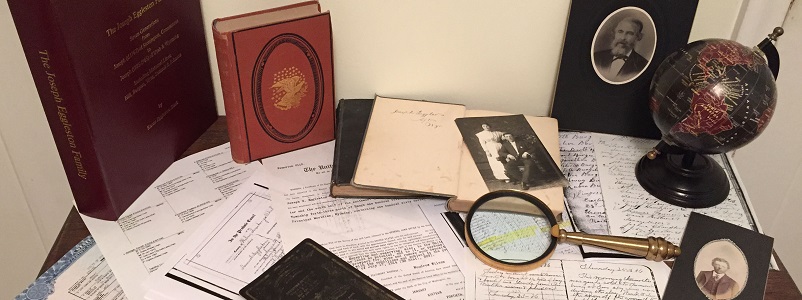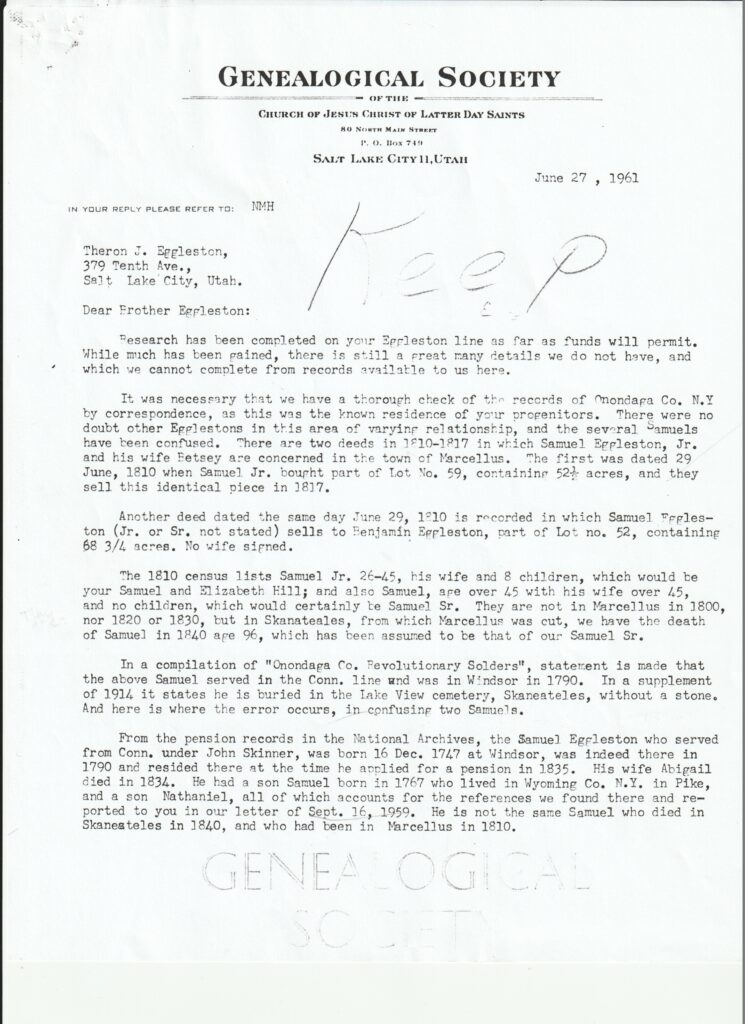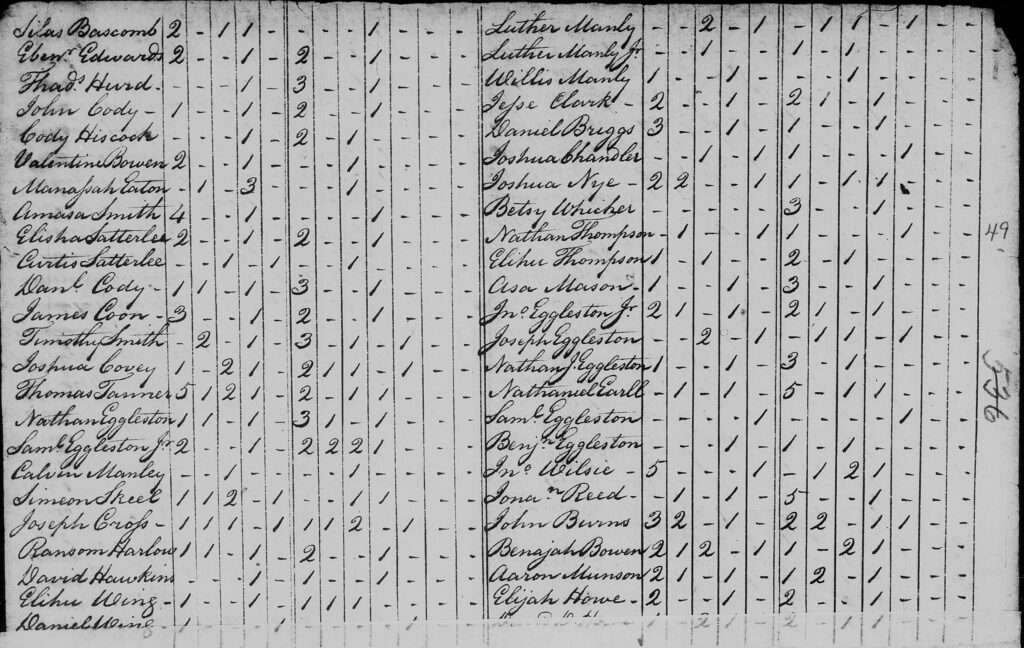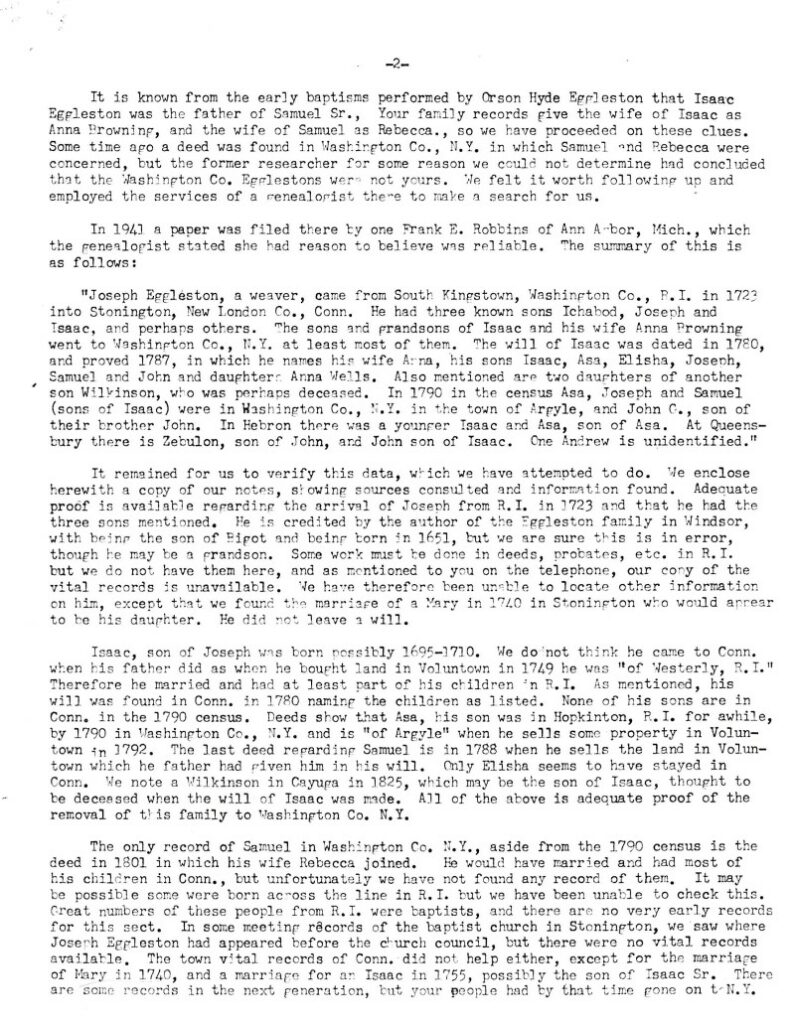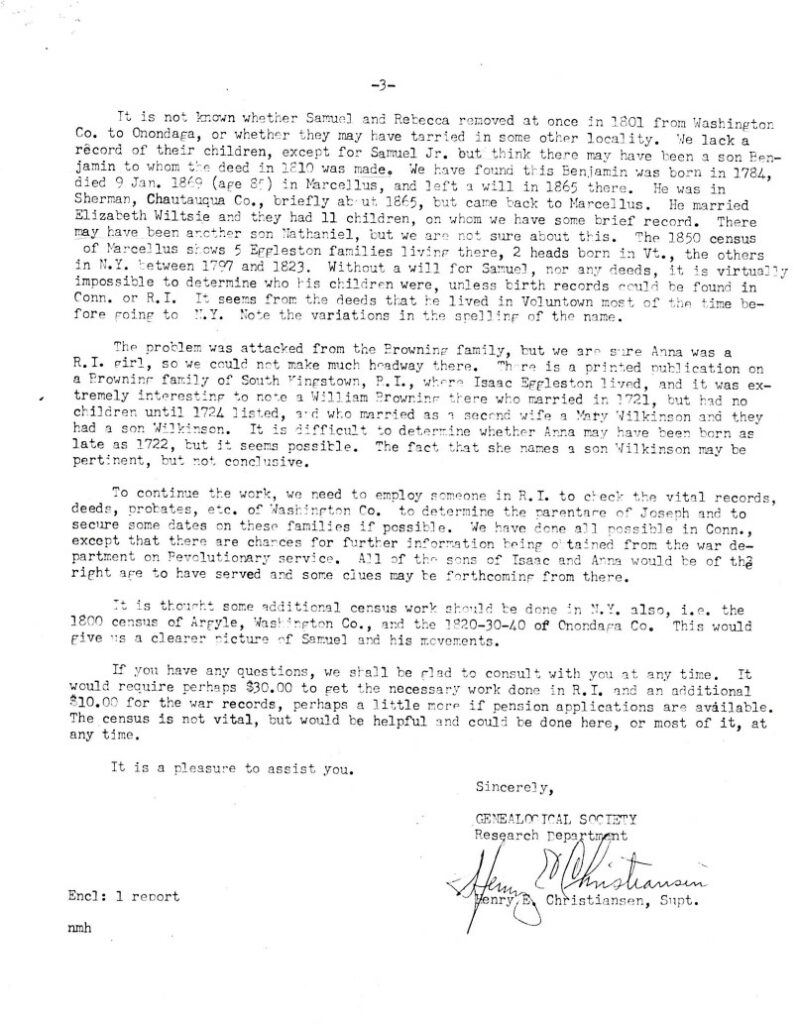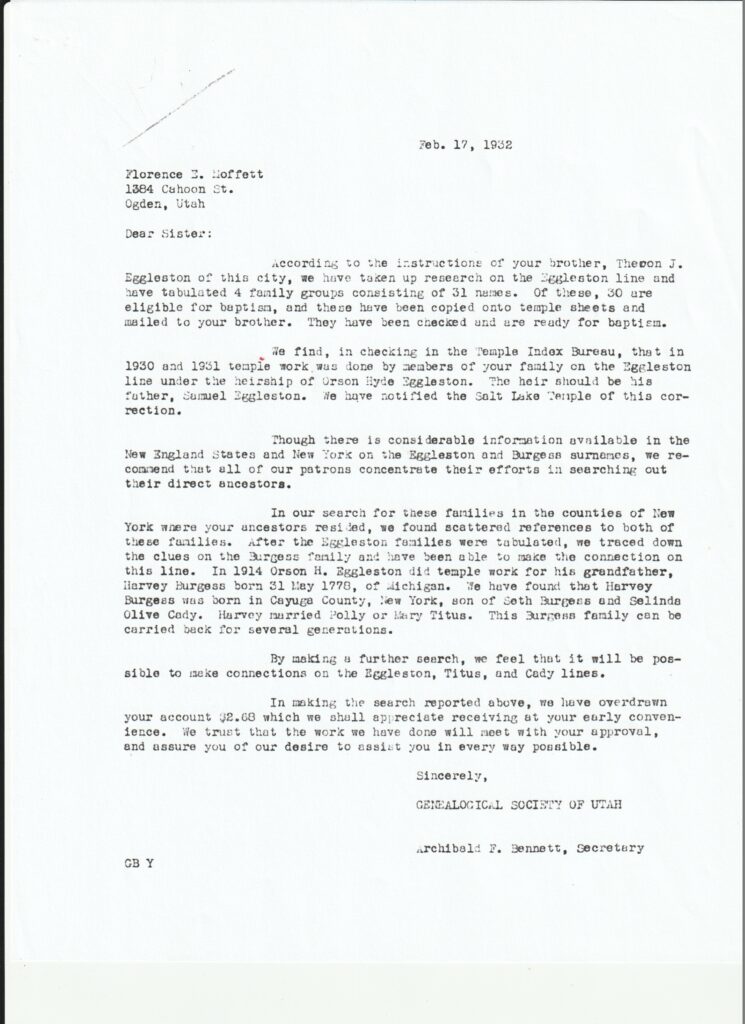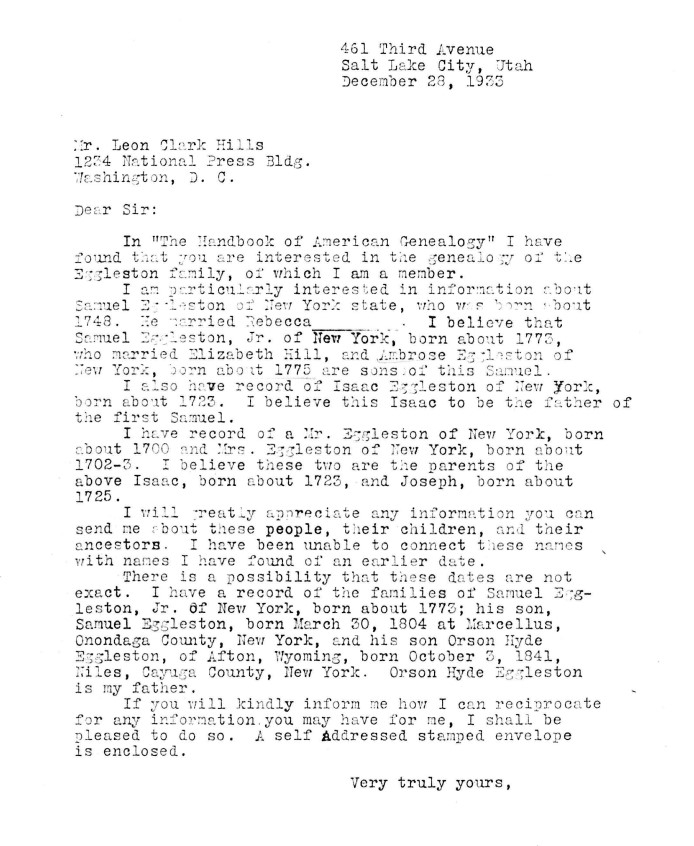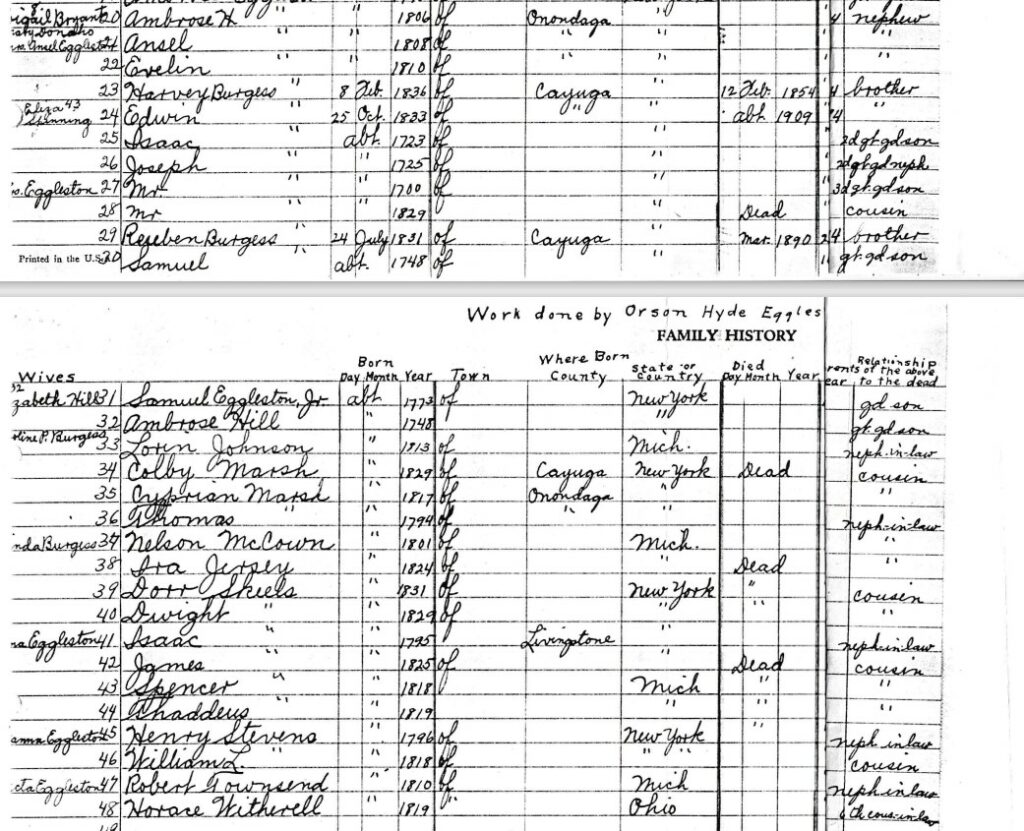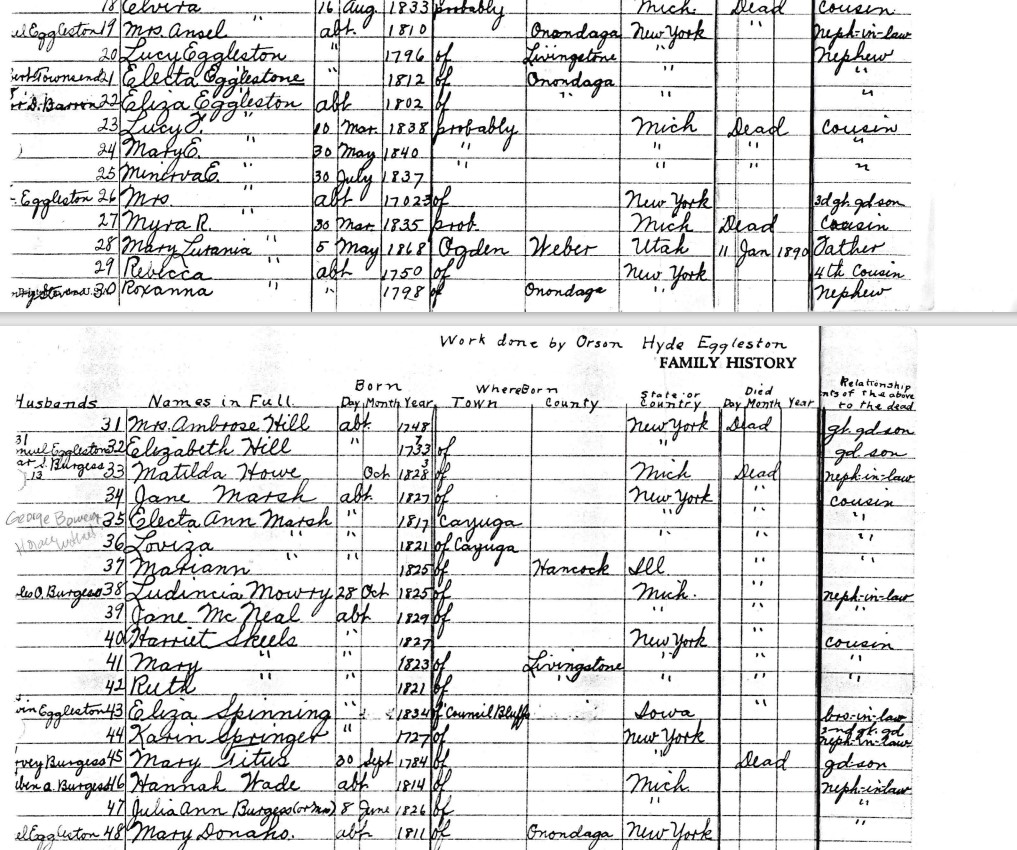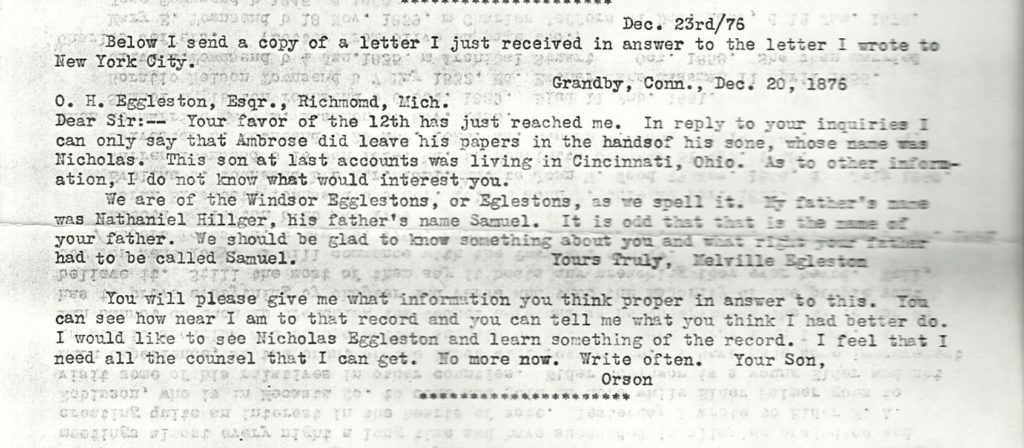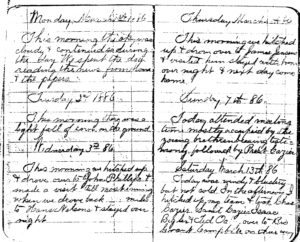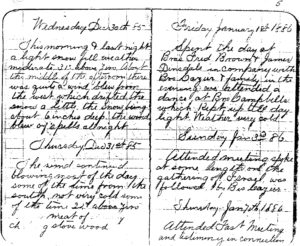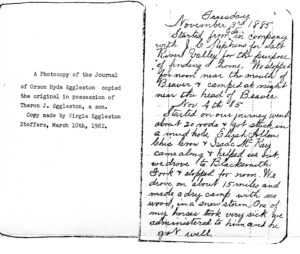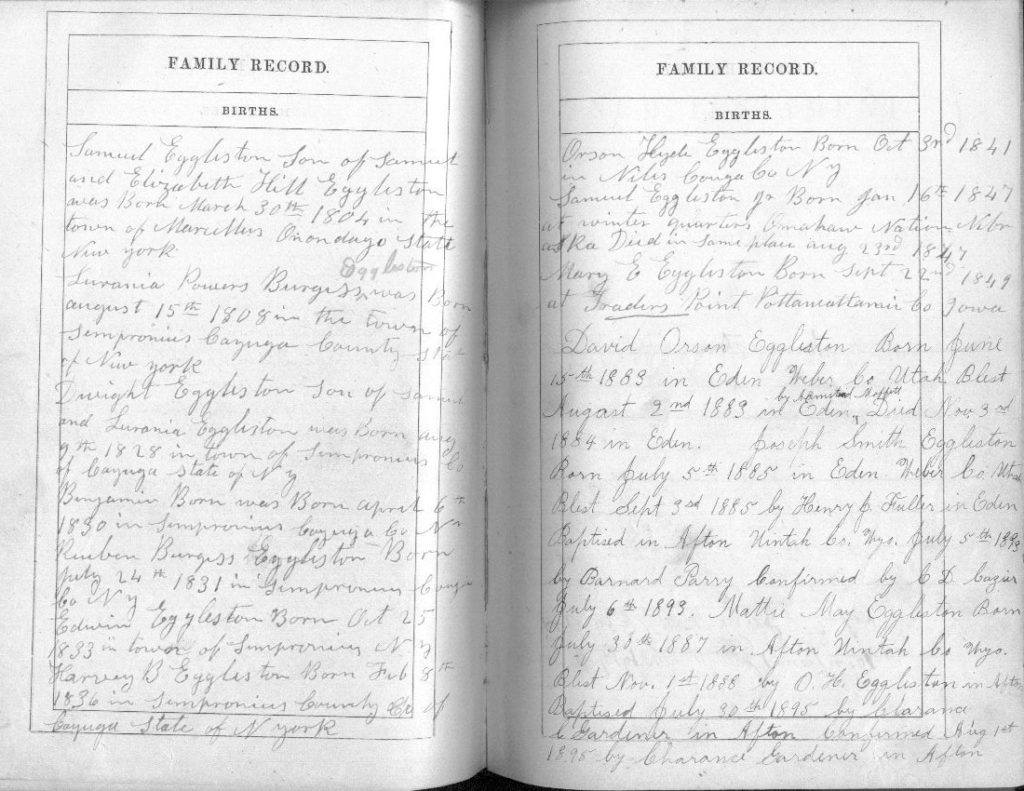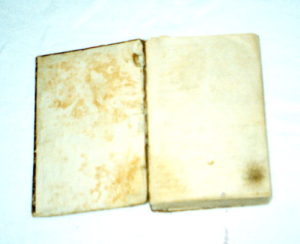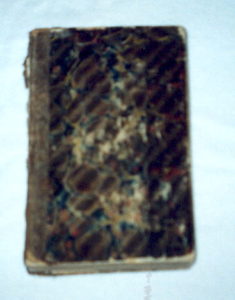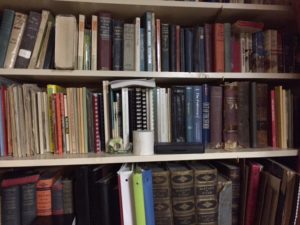Samuel and Rebecca Eggleston family
When I began researching, family records only listed two children of Samuel and Rebecca Eggleston – Samuel Jr. and Ambrose.
Samuel Sr. and his wife Rebecca moved from Argyle, Washington County, New York to Marcellus, Onondaga County, New York early in the 1800’s. A deed shows that they sold their land in Argyle in February 1801. On July 22, 1801, Samuel bought land in Marcellus from Luther Manley. This land was 100 acres of Lot #52.
I found two other deeds, which turned out to be my discovery of two other sons of Samuel and Rebecca. March 16, 1809, Samuel deeded about one third of this land to Nathan Eggleston for 50 cents and “for and in consideration of the natural love and affection he hath and beareth to his son the said Nathan.” June 29, 1810, Samuel deeded the remainder of his land to Benjamin Eggleston for $300. There was no “love and affection” clause with this deed, but all indications were that Benjamin was also his son. Samuel Jr. had bought his own land nearby.
This is my abstract of the deed of land from Samuel to Benjamin:
29 June 1810 SAMUEL EGGLESTON of Marcellus sold to BENJAMIN EGGLESTON for $300 part of Marcellus Lot 52 bounded on the west by lands owned by WYLLYS MANLY and LUTHER MANLEY and on the north by land owned by NATHAN EGGLESTON containing 68 and 2/3 acres. Signed: SAMUEL EGGLESTON. Witness: DANIEL KELLOGG 29th June 1810. Recorded DANIEL KELLOGG. (Onondaga Deeds Book P p. 382-383 FHL film 0870719)
Searching for Benjamin Eggleston
Samuel Sr. was not listed in the 1820 Census, but that year Benjamin Eggleston had an extra male over 45 in his household. In 1830 this was an 80-90 year old, and in 1840, 90-100 years old. It appears that Benjamin took over his father’s farm and cared for him until his death.
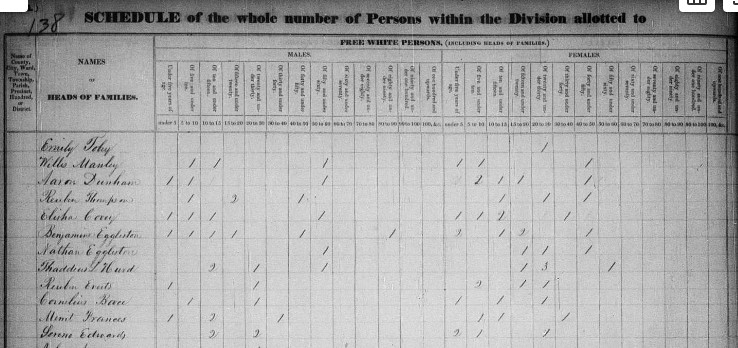
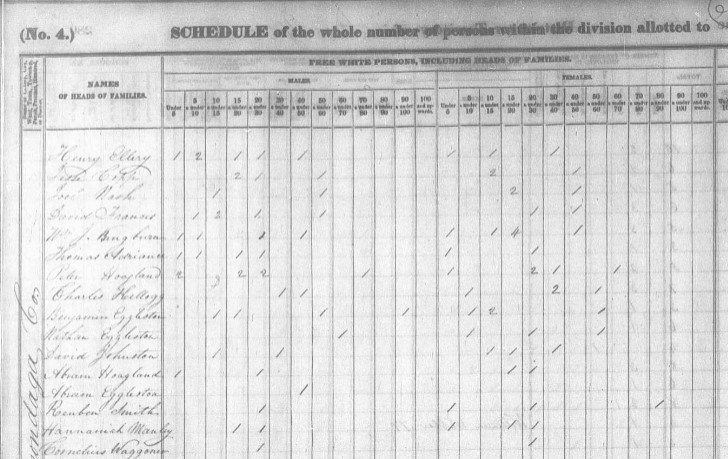
Burial and Probate Information
The discovery of these land records led to more research which found burial and probate records. More information was found through research on Benjamin’s wife Elizabeth Wiltse.
I found in a History of Spafford, Onondaga, New York a bio of Deacon Benjamin Eggleston. It quoted from his and family members’ headstones. (His and his wife’s are shown below) Most of the information here seems to have come from his will, dated February 18, 1865 and probated March 23, 1868. Mentioned were his wife, Elizabeth and children: Myron; Rolfe; John; Theodore, who married Sarah A. Gardner; Delilah Goodridge; Adeline Wood; Catherine Coon; Rebecca, who married Austin Wyckoff of Navarino, NY; Mary, who married Augustin Vanderburgh, son of Stephen and Maria (Calkins) Vanderburg; Ruth M. Eggleston and Sarah E. Patterson. (Spafford, Onondaga Co, NY 974.765/S1 V3c FHL)
This gave me enough information to add Benjamin and his children to the family and fill in as many details as I could find in census and other records.
Discovery
After doing this research for some time and piecing together Benjamin’s family, I finally discovered something that had been under my nose – literally – for some time. As I was cleaning up my messy desk one day in early 2001, I discovered a note I had scribbled and the lights went on in my brain. Occasionally as I researched and made connections online, people would ask me about various Egglestons. This note was about a contact from Barbara about a Berry or Benjamin Eggleston. At the time I had been contacted by Barbara, this name meant nothing, so I just put the note with others. Now it all made sense.
I was able to contact Barbara and we shared information. She sent me copies of some correspondence from 1987, information that appeared to have been compiled by some local historian, and a copy of a “Family Record” written for a 1911 family reunion. This had wonderful information about Benjamin’s children, including a son I was not aware of because he had died as a child and was not listed in Benjamin’s probate record.
The 1911 Eggleston Family Record
The “Family Record” is a brief history of the family of Benjamin and Elizabeth written for a family reunion held in 1911 in Chautauqua County. by C. W. Patterson. His record begins and ends with these statements:
More than a century ago the great, great grand parents of some of this gathering were born. Berry Eggleston in the year 1783 and his wife, Elizabeth Wiltsie was born Jan 1, 1789. They were married in 1808 and came to Onondaga Co. where they took up and cleared their farm on which they lived until their death, Benj. in 1868 and Elizabeth 6 years later, 1874 . . .
All this family were all of the old New England type being large of frame, strong and robust, upright and honest of character, sober and industrious and God fearing people, an honor to any community. We can any of us be proud to be descendants of these honorable forefathers.
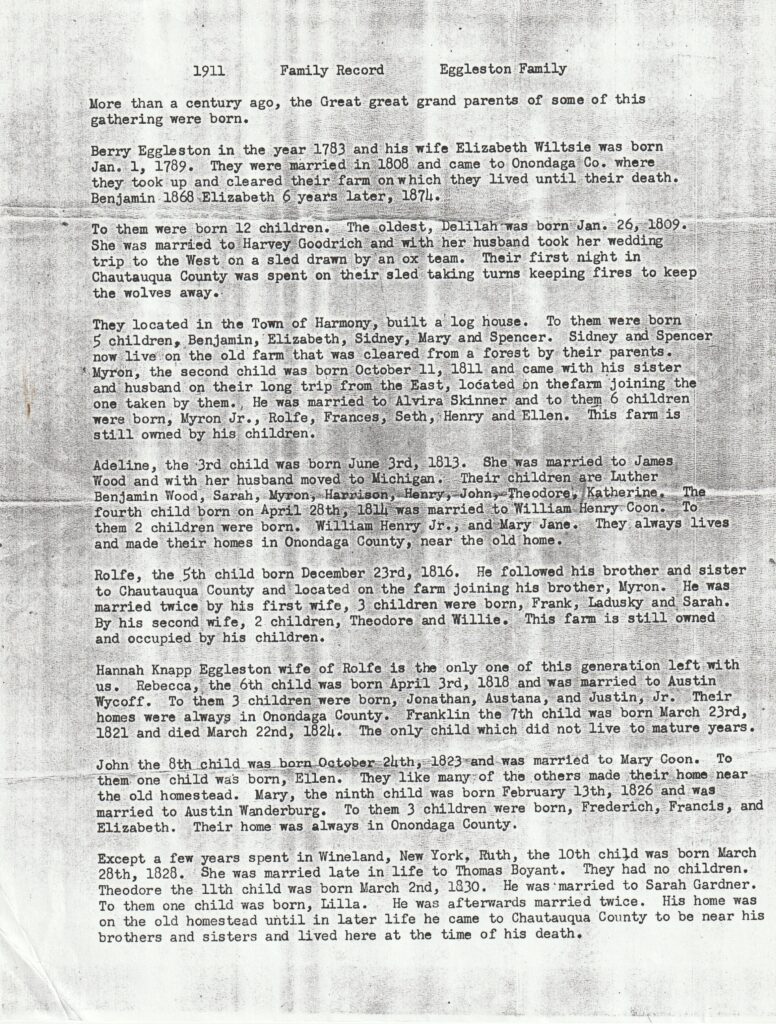
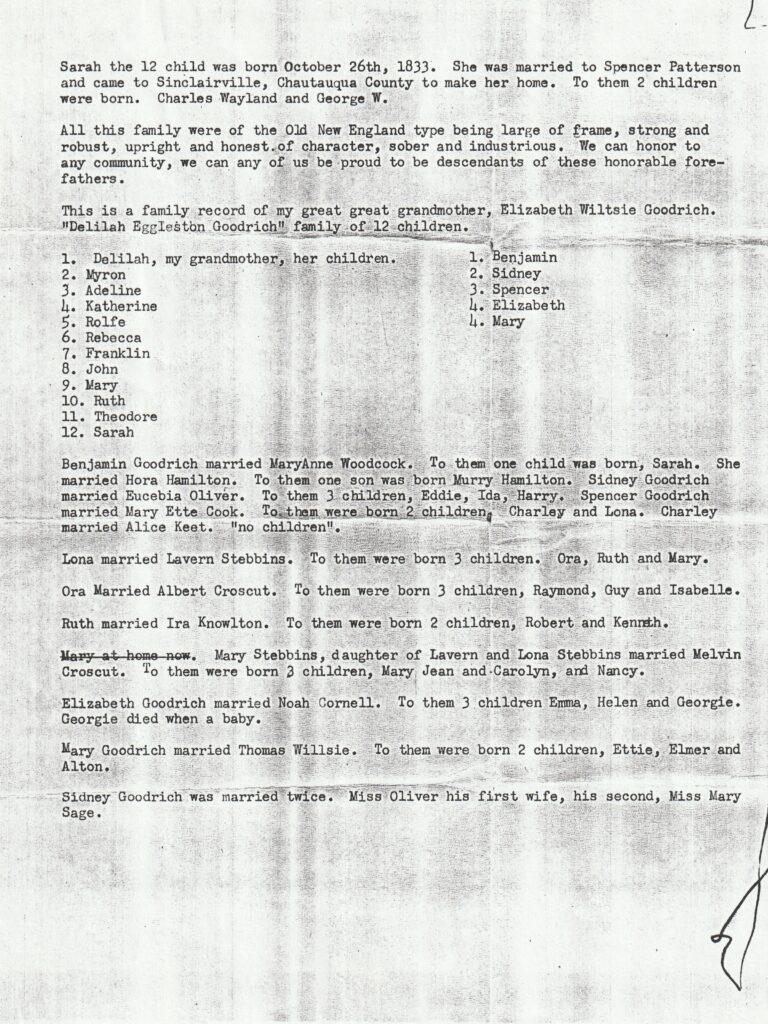
Correspondence
This is the letter Barbara received with information on this family, which references the above family history:
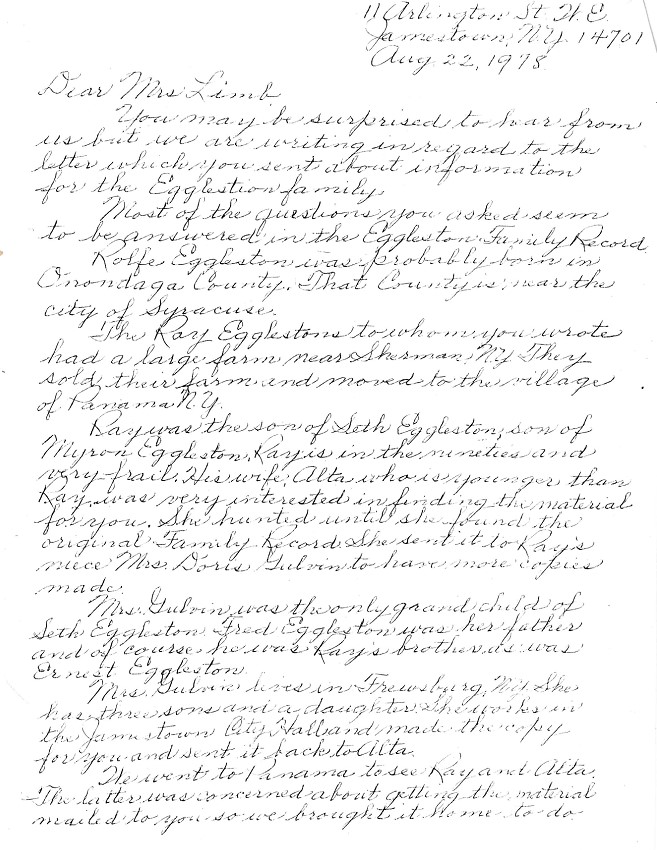
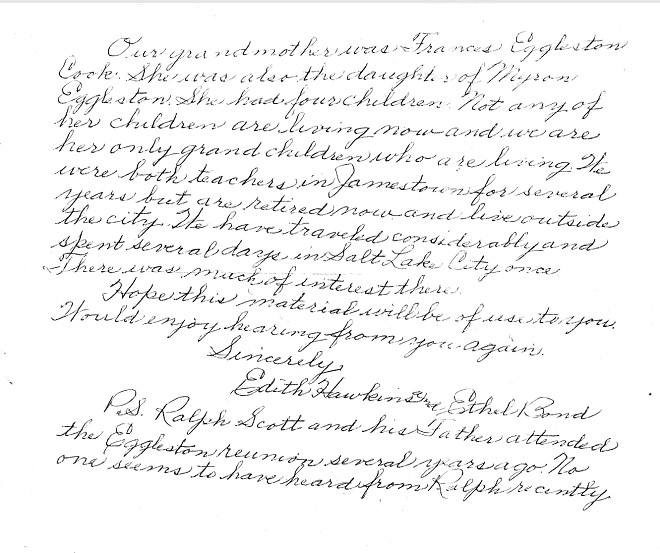
Barbara told me that she had gotten information from her uncle, Ralph Scott before he died. He was mentioned in this letter’s P.S. as being at a more recent family reunion. Ralph was the one who told Barbara that Benjamin’s son Franklin had died at age 3, which was obviously the reason he was not on other records. She mentioned that her uncle had in his basement in Detroit, family bibles, old letters, post cards, and pictures.
Interestingly a typed sheet, prepared by CNYGS (Central New York Genealogical Society) in Syracuse, included mention of the Administration of the estate of Thomas Tanner, among other details about various Egglestons. This note from “Memoirs of Phillipe Maton Wiltsie and His Descendants” by Jerome Wiltsie Sr. (1908) p 123 was in the middle of that sheet:
“Benjamin Eggleston m Elizabeth Wiltsie dau John & Polly (Burns) Wiltsie. She was b 1794, died in 81st year. Son: Theodore Eggleston, b 1830, res Sherman, Chautauqua Co.”
Benjamin’s Life
With this new information I was able to get a better picture of Benjamin’s life and family.
Benjamin was born in 1783. His birth place is different in different Census records: Washington County, New York, Connecticut or Rhode Island. Most likely he was born in the Stonington, Connecticut area.
Benjamin married Elizabeth Wiltse in 1808. Elizabeth was born January 1, 1789 in Vermont, a daughter of John Wiltse and Mary Burns. John Wiltse was one of the early settlers of Marcellus and was a neighbor of the Egglestons.
Information in a Wiltse history mentioned that Elizabeth and her husband Benjamin Eggleston resided in a house that her father built at Marcellus until 1865 when they moved to Sherman, Chautuaqua, County. It appears from census, land, and other records mentioning the “Eggleston farm near the Wiltse farm”, that the Wiltses were neighbors of the Egglestons. Benjamin bought his father’s land in 1810, when he had only been married a short time. Perhaps his father-in-law did build his house, but it likely was on his father’s land.
Benjamin did purchase some land in Chautauqua County, which he later sold to sons Myron and Rolfe. But it does not appear that he ever lived there himself. If he did, it would have been for a very short time. The Family Reunion sheet seems to say he lived in the same place until his death. Benjamin was buried in Marcellus, in the Thorn Hill Cemetery. Theodore however, though living with his father until 1865 at least, and possibly until his death, did move to Chautauqua County where he died and was buried.
It appears that Benjamin became quite a prosperous farmer and respected member of the community. A history of the town of Spafford listed Benjamin among the early settlers of the area. Since Benjamin was quite young at the time his father came to Marcellus, it is most likely he came with him. His brothers also probably came about the same time. The reason Benjamin was listed and not his father or brothers, is probably because he stayed and became a prominent member of the community, rather than that he came first. Benjamin also acquired a good deal of land in the area. He sold land in Marcellus to his sons Theodore and John.
In his later years Benjamin apparently lived with Theodore. Theodore and his wife Sarah did not have children for many years, so as Benjamin aged it would have placed a great burden on Theodore to farm his land. In the 1860 Census there appears to be hired laborers listed with the family. (This Census is very difficult to read and the names cannot all be made out). Benjamin’s daughter Ruth did not marry until she was quite old. She was living with them and probably helped to take care of her aging parents.
Marcellus Church Records
Benjamin and his wife Elizabeth were baptized and joined the Thornhill Baptist Church May 21, 1828. He would have been about 45 years old, so joined the Church at a much older age than his brothers had and after Samuel and Nathan had moved away. Why he was not baptized at a younger age is unknown. Perhaps his brother’s later experiences with being excluded from the church influenced him.
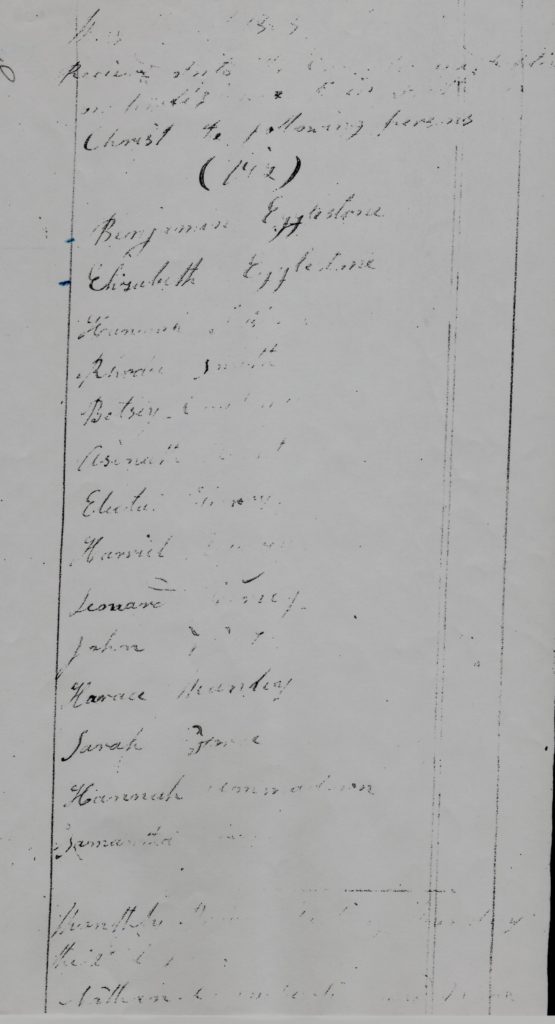
From the time of his baptism, Benjamin was very involved in the Church. In May 1837, he was chosen chairman of the board of trustees of the First Baptist Religious Society of Marcellus. In 1841, he and Stephen Vandenburgh were chosen trustees. He would have been involved in decisions and planning for the original church building and the present building, which was built in 1849. Benjamin was mentioned in Mortuary Notes and also in a newspaper notice of his daughter’s marriage as “Deacon”. As Deacon, Benjamin had many assignments to visit brethren and sisters, participated in meetings, and other activities.
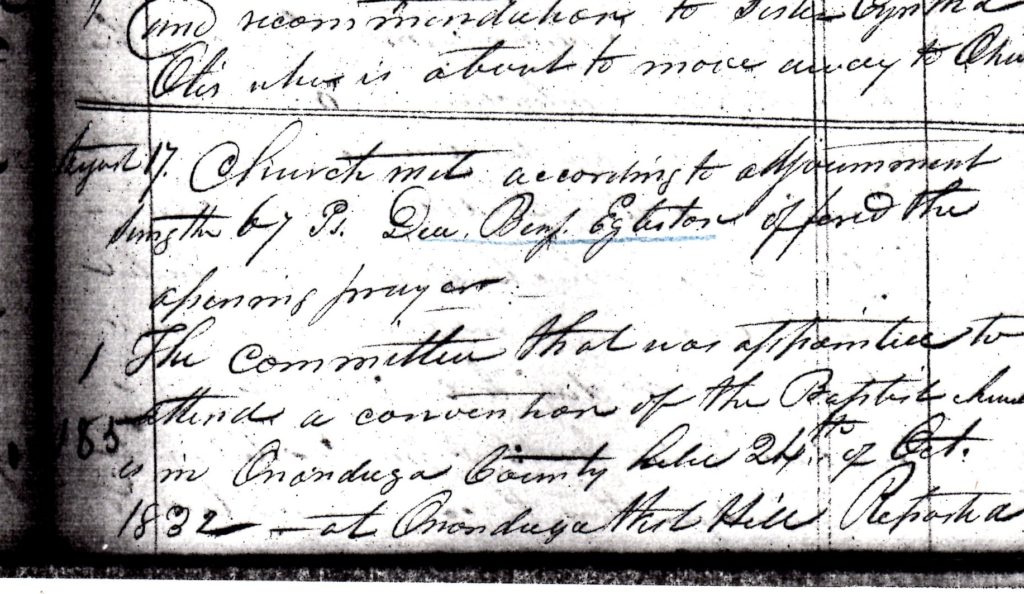
Benjamin’s son Theodore married Sarah A. Gardner, whose father Sylvester Gardner, was the Pastor of the Thorn Hill Baptist Church at the time. This family was also a neighbor as they were listed next to each other on the 1850 Census.
In August 2001, I was able to visit this Church in Marcellus, New York. The Pastor showed my father and I the church records and allowed us to make some copies. We were also able to visit the graves of Benjamin and his wife Elizabeth in the cemetery there.
Death of Benjamin Eggleston
Benjamin died January 9, 1868 and was buried in the Thorn Hill Cemetery behind the Church in which he was an active member. His headstone inscription reads: “Our Father Dea Benjamin Eggleston left us January 9, 1868, in the full assurance of a blissful immortality, through Christ his Saviour, age 85 years.” The Spafford Mortuary Records published by the Onondaga Historical Association also added the line “Precious in the sight of the Lord is the Death of his Saint.”
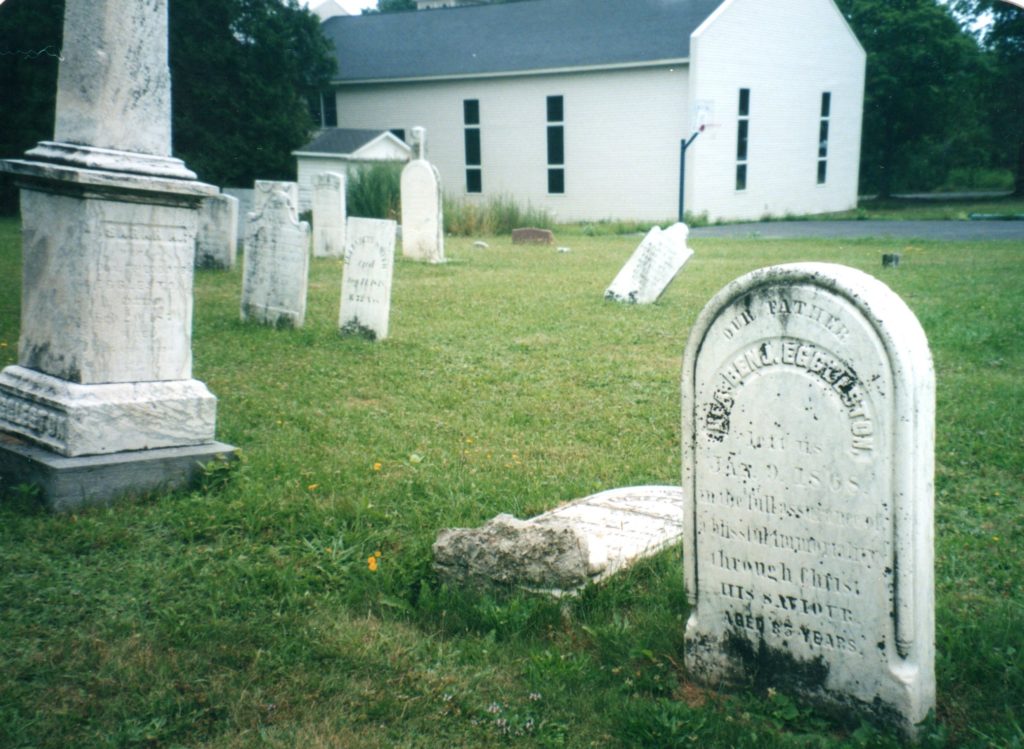
Elizabeth died August 31, 1874. She was buried alongside her husband in the Thorn Hill Cemetery. Sadly upon our visit in August 2001, we found her headstone lying on the ground. The inscription reads: “Our Mother Elizabeth, wife of Dea Benjamin Eggleston Departed this life August 31, 1874, age 85 years, 5 months.” The Mortuary Records added the phrase “With a good Hope in Christ of a Blessed and glorious Resurrection to Eternal Life.” The 1875 New York Census listed deaths during the year ending June 1, 1875 and listed Elizabeth Eggleston age 85 died August 31 of old age. A Wiltse Family history gave Elizabeth’s birth as 1794 and indicated she died in her 81st year.
